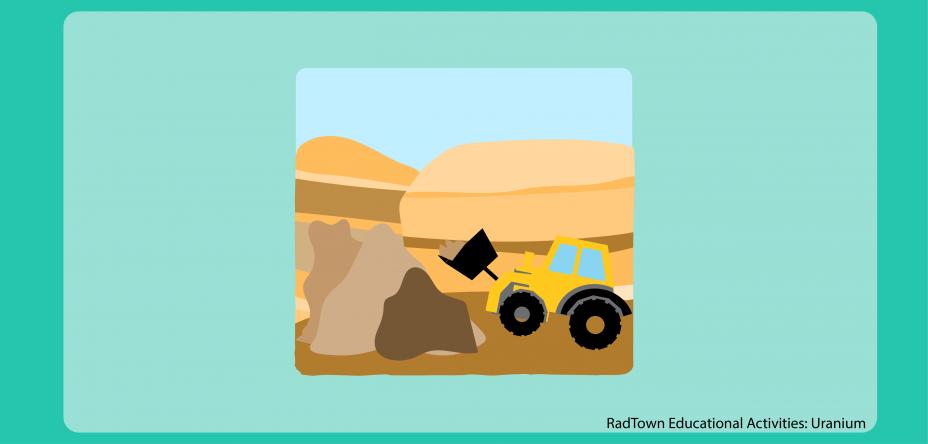RadTown Uranium Activity 5: Radiation Contamination and Exposure
Radiation is all around us, all the time, mostly from natural sources. However, many Native American and Alaska Native communities have been further exposed to radiation as a result of man-made activities including uranium mining and milling and nuclear testing. This activity explores how radioactive contamination and exposure work using multiple hands-on activities. This activity is intended for middle and high school students.
- Objectives
- Next Generation Science Standards
- Materials and Resources
- Time
- Vocabulary
- Directions
- Common Core State Standards
Objectives
Students will:
- Develop a radiation web or model to show how radiation can contaminate the environment, animals and people.
- Examine the three main exposure pathways: inhalation, ingestion and direct (external) exposure; and basic radiation protection measures.
Next Generation Science Standards
The concepts in this activity can be used to support the following science standard:
- ESS3. Earth and Human Activity
Materials and Resources
Each italicized document title can be found at the bottom of this page, and is available for printing and distribution.
- Uranium: Teacher Background Information
- Vocabulary Materials
- Art supplies for students; for example, paper or poster board, magazines, colored pencils and markers (optional for Step 4)
- Materials to create a watershed (optional for Step 4). Visit Build Your Own Watershed for a detailed materials list.
Time
You may choose to have students complete the entire activity within one or two class periods. If time or computer access is limited, the activity can be introduced, completed outside of the class and concluded in another class period.
Vocabulary
- Direct exposure
- Exposure pathways
- Inhalation
- Ingestion
- Ionizing radiation
- Man-made radiation
- Natural (background) radiation
- Radioactive contamination
- Radon
- Uranium
- Uranium mining
Directions
- Start with a vocabulary activity if students are not familiar with uranium and the vocabulary used in this activity.
- Explain that natural (background) radiation is all around us and has been present since the birth of this planet. However, many Native American and Alaska Native communities have been further exposed to radiation as a result of man-made activities including uranium mining and milling and nuclear testing. In the mid-1940s, with the dawn of the nuclear age, hundreds of uranium mines and dozens of mills were established and significant nuclear testing took place. Once the uranium supply exceeded the demand in the 1970s, uranium mines and mills began to shut down. Nuclear testing continued until 1992. Some of these mining, milling and testing sites were abandoned and not properly cleaned up. As a result, some Native American and Alaska Native communities are deeply impacted by contaminated soil, air, water and materials that were left behind.
- Ask students how we might be exposed to radiation in contaminated soil, air, water and materials. Confirm or explain that routes of radiation exposure include direct or external exposure, inhalation and ingestion. We cannot see radiation, but if we are aware of radiation sources (such as abandoned mines and equipment, mine tailings, high radon levels, and contaminated water, soil and building materials) we can apply three basic radiation protection concepts to reduce our exposure to radiation:
- Limiting time near a radiation source.
- Increasing the distance from a radiation source.
- Shielding by placing material or a barrier between a person and a radiation source.
- Direct students to list, model or draw possible routes or pathways of exposure (direct or external exposure, inhalation and/or ingestion) to radioactive materials for uranium mining, milling, nuclear testing or nuclear waste. Students can also identify radiation exposure pathways for natural radiation sources or accidents (e.g., transportation accident that releases radioactive materials into the environment or a nuclear reactor meltdown).
- List ways in which people may be exposed to radiation according to the three main pathways: direct or external exposure, inhalation and ingestion.
- Create a watershed model to simulate how radioactive soil can dissolve and contaminate a common body of water that can serve as drinking water for people and animals or be used for watering plant food sources. Students can use a spray bottle to represent rain. Students can also use their breath or a small fan to model how materials can be blown into the air or into water sources.
- Diagram exposure routes or pathways in the form of radiation webs (similar to the example provided on the following page) using paper and art supplies or electronic software to create their diagrams.
Common Core State Standards (CCSS)
The concepts in the Radiation Contamination and Exposure activity align with the following:
- CCSS English Language Arts Standards for Literacy in History/Social Studies, Science, & Technical Subjects:
- CCSS.ELA-LITERACY.SL.6-12.2 Comprehension and Collaboration
- CCSS.ELA-LITERACY.SL.6-12.5 Presentation of Knowledge and Ideas
- CCSS.ELA-LITERACY.WHST.6-12.9 Research to Build and Present Knowledge

